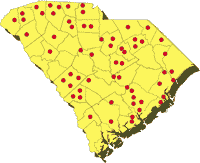How Was the Program Established
Aquatic Plant Management Program
Invasive aquatic weed problems are such a large problem in South Carolina the state legislature established the Aquatic Plant Management Program for the purpose of preventing, identifying, investigating, managing, and monitoring aquatic plant problems in public waters.
The Department of Natural Resources administers the Aquatic Plant Management Program in coordination with the S.C. Aquatic Plant Management Council, a ten member board representing several state agencies and the Governor's Office.
Aquatic Plant Management Plan
Each year, a statewide Aquatic Plant Management Plan is prepared, reviewed by the public, approved by  the Council, and implemented using public and private funds. Over 60 public water bodies throughout the state have benefited from these control activities including the Santee Cooper lakes, Lake Murray, Back River Reservoir, Goose Creek Reservoir, the Cooper River, Black River, Pee Dee River, Waccamaw River, and numerous State Park Lakes. Public comments on the plan are encouraged. Funding for the annual control work comes from several sources; local cooperators (such as utility companies or local/county government), state funding, and Federal funding cost share matching programs
the Council, and implemented using public and private funds. Over 60 public water bodies throughout the state have benefited from these control activities including the Santee Cooper lakes, Lake Murray, Back River Reservoir, Goose Creek Reservoir, the Cooper River, Black River, Pee Dee River, Waccamaw River, and numerous State Park Lakes. Public comments on the plan are encouraged. Funding for the annual control work comes from several sources; local cooperators (such as utility companies or local/county government), state funding, and Federal funding cost share matching programs
Aquatic Nuisance Species: The Law!
South Carolina, like other states, has adopted laws to prevent the importation, sale, and distribution of specific invasive aquatic plant species known to cause problems. The South Carolina Noxious Weed Act and State Crop Pest Act provide far reaching powers to "seize, quarantine, treat, destroy, or otherwise dispose of any noxious weed," imported, distributed, or sold in South Carolina. To further deter persons from spreading nuisance aquatic weeds the law includes fines up to $500 and/or imprisonment up to one year. The Department of Natural Resources is assisting in the implementation of these laws and others to keep these problem plants out of South Carolina.
How you can help!
Prevention may be the key to reducing costs and acreages of these invasive species. Aquatic weed problems are caused primarily by boaters and fishermen unknowingly spreading aquatic weeds from one lake to another and homeowners disposing of water garden and aquarium plants in public waters and private ponds. You can help control the spread of nuisance aquatic plants by doing the following:
When you leave a body of water:
-
Remove any visible mud, plants, fish or animals before transporting equipment.
-
Eliminate water from equipment before transporting.
-
Clean and dry anything that comes into contact with water (boats, trailers, equipment, clothing, dogs, etc.).
-
Never release plants, fish or animals into a body of water unless they came out of that body of water.
-
Report aquatic weed problems in public waters to the Aquatic Nuisance Species Program, SCDNR (1-803-755-2836 or email:invasiveweeds@dnr.sc.gov).
Sections include:
- Why Manage Invasive Species
- How Was the Program Established?
- Homeowner Information gives you the do's and don't

